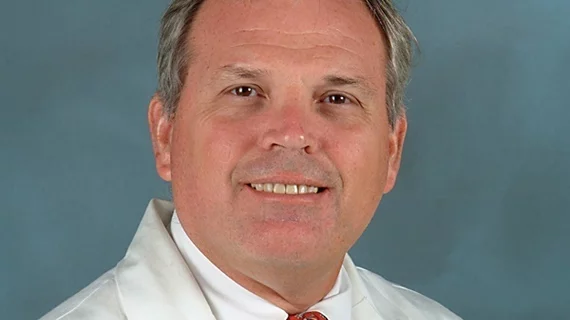3 key takeaways from Bibb Allen’s ACR presidential address
Bibb Allen Jr., MD, department of radiology at Grandview Medical Center in Birmingham, Alabama, served as the 2016-2017 president of the American College of Radiology (ACR) and delivered the presidential address at the ACR 2017 Annual Meeting in Washington, D.C.
“Whether it is in a radiology organization or in a radiology practice, in an academic center or a small community hospital, on Fifth Avenue or on Main Street in middle America, keeping our patients at the center of what we do as a principal strategy for our organizations and practices is key for radiologists to demonstrate their value in health care,” Allen said that night. “And I firmly believe that letting what is best for our patients guide our decision making will ensure a bright future for our practices and our specialty because using our knowledge and our tools to improve the health and care of our patients is our primary goal.”
Allen’s full presidential address has now been published by the Journal of the American College of Radiology. These are three key takeaways from the speech:
1. The ACR will always work to “stay ahead of the curve.”
“Staying ahead of the curve” was a theme throughout Allen’s address. The ACR has stayed ahead of the curve for years, he said, even though it hasn’t always been easy. For example, the ACR introduced appropriateness criteria back in the early '90s, when no other specialties were focused on value-based care, and it took a lot of patience. But that patience paid off. Value-based care is now one of the most important topics in all of healthcare—and radiologists have been a part of that conversation since the very beginning.
As much has changed over the years, Allen said the ACR remains committed to always thinking ahead and helping radiology lead healthcare into the future.
“As we have seen, staying ahead of the curve is a fragile place that requires constant vigilance and relies on our ability to adapt to and embrace the opportunities that come our way,” Allen said. “But you know you are in the right place when your decisions—whether they are for our organization or in your own practices—feel, as my children would say, a bit ‘edgy.’ That’s the place we want to be—just ahead of the curve.”
2. Radiologists have proven they are a part of the solution in healthcare—not a part of the problem.
The growth of certain imaging services helped contribute to rising healthcare costs in the United States. Of course, Allen said, this led to reimbursement changes that hurt radiology in the short term—but it also led to something positive.
“We needed a different story to tell Congress, CMS, and our colleagues—a story that shows radiologists can be part of the solution, not part of the problem,” Allen said. “And so, 5 years ago we began developing our Imaging 3.0 road map and toolkit to demonstrate how radiologists bring value to our patients and our health care systems beyond our interpretations.”
As a result of radiology’s continued focus on quality over quantity and value over volume, the profession is no longer seen as a part of the problem. The specialty has led by focusing on value-based care and demonstrating how important radiologists are to healthcare as a whole.
Again, Allen noted, the hard work of radiologists has helped the specialty stay ahead of the curve.
3. Radiologists can work closely with artificial intelligence to provide even more value to patients.
Allen said he would be remiss if he didn’t take time to discuss the trend on the tip of every imaging professional’s tongue: artificial intelligence (AI). AI will change patient care in a number of ways, he said, but that doesn’t mean robots will be replacing radiologists. If they did, it simply wouldn’t be best for patients.
“If you believe our value stems from image interpretation alone, it is possible that decades from now, algorithms could be developed that are robust enough to detect and characterize many diseases as well as we do,” Allen said. “But if you believe, as I do, that radiologists can provide much more value to our patients than just image interpretation, then we are uniquely positioned to bring advances in data science to our health care teams by becoming the managers, integrators, and communicators of our patients’ digital information.”
Advances in AI, Allen added, are inevitable. So why not take control and lead the way?
“The technology will develop, and we will not be able to stop it,” he said. “Nor, by the way, should we want to. Any attempt to obstruct its development will be counterproductive because if we are not involved at the beginning, we risk being leapfrogged and cajoled into accepting technology that is not optimized to benefit patient care or the role of radiologists. I firmly believe that our patients will benefit most if radiologists and the ACR play a leading role in the implementation of artificial intelligence in medical imaging.”
Related Content with Bibb Allen:
VIDEO: Where are we with AI adoption in radiology?
VIDEO: Validation monitoring for radiology AI to ensure accuracy
VIDEO: AI for stroke detection on CT imaging
Concerns raised over how hospitals can validate radiology AI algorithms
ACR strengthens focus on AI development through new collaboration with the National Cancer Institute
Most radiologists using AI favor ‘home-grown’ algorithms over commercially available tools

